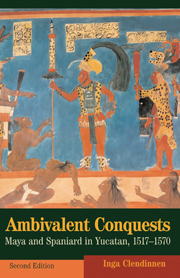Book contents
- Frontmatter
- Contents
- List of illustrations
- Preface to the second edition
- Preface to the first edition
- Acknowledgments
- Map I Yucatan in the conquest period
- Part I Spaniards
- Part II Indians
- 9 Finding out
- 10 Connections
- 11 Continuities
- 12 Assent
- Epilogue: Confusion of tongues
- Appendix: A sampler of documents
- Glossary of Spanish and Maya terms
- Notes
- Select bibliography
- Index
10 - Connections
Published online by Cambridge University Press: 05 October 2013
- Frontmatter
- Contents
- List of illustrations
- Preface to the second edition
- Preface to the first edition
- Acknowledgments
- Map I Yucatan in the conquest period
- Part I Spaniards
- Part II Indians
- 9 Finding out
- 10 Connections
- 11 Continuities
- 12 Assent
- Epilogue: Confusion of tongues
- Appendix: A sampler of documents
- Glossary of Spanish and Maya terms
- Notes
- Select bibliography
- Index
Summary
Then with the true God, the true Dios, came the beginning of our misery. It was the beginning of tribute, the beginning of church dues, the beginning of strife with purse-snatching, the beginning of strife with blow-guns, the beginning of strife by trampling on people, the beginning of robbery with violence, the beginning of debts enforced by false testimony, the beginning of individual strife, a beginning of vexation, a beginning of robbery with violence. This was the origin of service to the Spaniards and priests, of service to the local chiefs, of service to the teachers, of service to the public prosecutor by the boys, the youths, of the town, while the poor people were oppressed. These were the very poor people who did not depart when oppression was put upon them …
But it shall still come to pass that tears shall come to the eyes of our Lord God …
Prophecy for Katun 11 AhauIf Montejo's Spaniards were disappointed, as they moved in from the coast, with the modest size of Maya settlements, they should perhaps have wondered why there were any substantial settlements at all. The peninsula imposed narrow limits on its human users. Each milpa could be cropped only for two or three seasons before too stubborn regrowth forced its relinquishment back to the forest for seven or ten or more years. To live in a group therefore meant to spend time trekking back and forth to the milpa, as each household required access to a substantial area of land.
- Type
- Chapter
- Information
- Ambivalent ConquestsMaya and Spaniard in Yucatan, 1517–1570, pp. 139 - 153Publisher: Cambridge University PressPrint publication year: 2003

